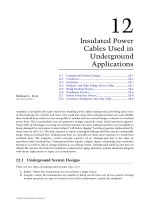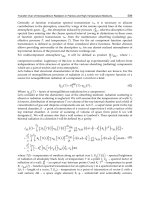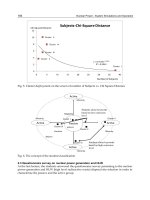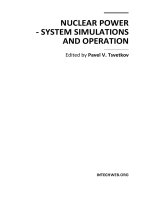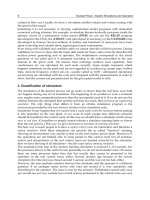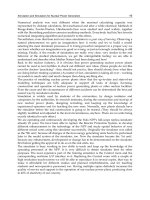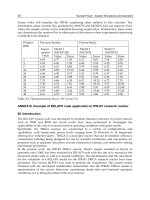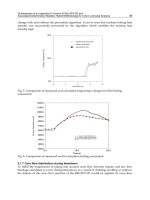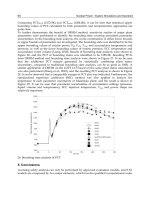Nuclear Power System Simulations and Operation Part 14 docx
Bạn đang xem bản rút gọn của tài liệu. Xem và tải ngay bản đầy đủ của tài liệu tại đây (263.2 KB, 9 trang )
Nuclear Power - System Simulations and Operation
184
Cluster I
Cluster II
Cluster III
Cluster IV
Cluster V
y = 8.3545e
-0.096x
R² = 0.9062
0
2
4
6
8
10
12
0 5 10 15 20 25 30 35 40
Subjects-Chi-Square Distance
Number of Subjects
Chi-Square Distance
Fig. 5. Cluster deployment on the screen of number of Subjects vs. Chi Square Distance
Majority
Minority
Minority
Minority
Minority
Passive
Active
Active
Active
Active
Students chose keywords
based on low conscious
level
Students chose keywords
based on high conscious
level
Instinct
Emotion
Reason
Cluster I
Cluster II
Cluster III
Cluster V
Cluster IV
Fig. 6. The concept of the student classification
2.3 Questionnaire survey on nuclear power generation and HLW
At the last lecture, the students answered the questionnaire survey pertaining to the nuclear
power generation and HLW (high level radioactive waste) disposal site selection in order to
characterize the passive and the active group.
The Text-Mining Approach Towards Risk Communication in Environmental Science
185
The questionnaire composed of these questions from A to G as below. The students selected
the number from 7 (yes, I guess so very much) to 1 (no, I do not guess so at all) at every
question.
Questionnaire A: necessity of nuclear power generation;
“Do you think nuclear power generation is necessary?”
Questionnaire B: approval for facility installation of nuclear power generation;
“Do you think it is no problem for the installation of nuclear power generation
plant?
Questionnaire C: accepttance of adjoining nuclear power generation facility;
“Would you say “yes” if the local authority proposed you the construction of a
nuclear power generation plant adjacent tot your place of residence?”
Questionnaire D: cognition of high level radioactive waste;
“Do you recognize HLW generated in the nuclear power plant?”
Questionnaire E: necessity of HLW disposal facility;
“Do you think the HLW disposal facility is necessary?”
Questionnaire F: approval for facility installation of HLW;
“Do you think it is no problem for the HLW disposal facility?”
Questionnaire G: acceptance of adjoining HLW disposal facility;
“Would you say “yes” if the local authority proposed you the construction of a
geological disposal site adjacent to your place of residence?”
The author implemented ANOVA to find the significant difference between above two
groups by using numerical answer of the questionnaires.
The result showed in Table 6, which revealed that there were no significant difference
between the two groups in the consciousness toward nuclear power generation and
necessity of HLW disposal facility and approval for the facility installation. However, there
was a significant difference in the reluctant consciousness against adjoining facility
installation.
This result suggested that the Active group in the theme of nuclear power generation had the
positive stance toward the waste management of nuclear power generation. They felt the
responsibility for the back-end procedure, in other words.
The students who belonged to the Active group believed that they had to face both side of
science and technology, such as a benefit and disadvantage of nuclear power generation.
They thought that nuclear power generation had the merit for energy security and
environmental preservation. Conversely, they thought that it had the demerit of the
requirement for long-life management of the high level radioactive waste.
On the other hand, the students who belonged to the Passive group did not have such a
subjective attitude.
It would be the first to make an effort to share the feelings between a speaker and a listener
(students of the passive group) by beginning the topics about their interest. If a speaker
succeeded in getting the listeners’ trust, a speaker would be easy to discuss the point of that
theme. However, as the students of Passive group chose the keywords heuristically, it was
difficult to get their interests. Therefore, the author paid attention to the keywords of other
themes chosen by the Active group toward the HLW site selection.
Nuclear Power - System Simulations and Operation
186
Necessity
of
Nuclear power
generation
Approval
for
facility
installation
Accept
of
adjoining facility
5.5 (1.20) 3.9 (1.25) 2.8 (1.67)
5.8 (0.87) 4.3 (0.99) 3.3 (1.31)
n.s. n.s. n.s.
*
:
significant, p
<
0.05
The numerical value in each group indicate the average of ordinal scale of approval, such as " I
guess so very much (7 point)", "neutral (4 point)", "I don't guess so at all (1point)" respectivly. The
numerical value in a parenthesis shows standard deviation.
Nuclear power generation
Active group
significance
Items of
questionaire
survey/group
Passive group
Items of
questionaire
survey/group
Cognition
of
HLW
Necessity
of
disposal facility
Approval
for
facility
installation
Accept
of
adjoining
facility
Passive group
3.9 (0.64) 4.3 (0.71) 3.4 (0.92) 1.9 (1.13)
Active group
3.5 (0.88) 4.4 (0.65) 3.9 (0.68) 3.1 (1.25)
significance n.s. n.s. n.s.
*
* : significant, p<0.05
The numerical value in each group indicate the average of ordinal scale of approval, such as " I guess
so very much (7 point)", "neutral (4 point)", "I don't guess so at all (1point)" respectivly. The numerical
value in a parenthesis shows standard deviation.
HLW
Table 6. Result of ANOVA on the questionnaire survey pertaining to the nuclear power
generation and HLW
The fifth theme of the lecture, household waste management, was a suitable issue to find the
common element between the nuclear power generation and household waste management.
The third theme of the lecture, precautionary principle, was also taken to find the common
element. Because the characteristics to avert the risk at first would bring the chaos into the
discussion of the site selection of HLW disposal, it would be difficult to achieve the social
consensus.
3. Discussion
3.1 The attitude for the environmental scientific-related theme
In order to grasp the communication viewpoints, the author investigated the interest of the
Active group in the field of environmental science such as the household waste management
and the precautionary principle by using keyword cross table and correlation analysis.
3.1.1 Correlation with the keywords at the lecture on the household waste
management and those on nuclear power generation
As shown in the Table 7 of the cross table which shows the keyword group obtained in the
lecture of nuclear power generation and the lecture of household waste management,
The Text-Mining Approach Towards Risk Communication in Environmental Science
187
twenty six of the students (the largest number of the students) submitted the keyword of
“nuclear power generation“. The eleven students (the second largest number of the
students) submitted the keyword of “MOX fuel (plutonium-uranium mixed fuel utilization)
“at the lecture of nuclear power generation.
At the fifth lecture of household waste management, seventeen of above mentioned
students who had selected “nuclear power generation“ and “MOX fuel (plutonium-uranium
mixed fuel utilization) “ submitted the keyword of “recycle“and four of above mentioned
submitted the keyword of “waste“. These two keywords of “recycle“ and “waste“ were also
top two of the submitted keywords at the lecture of general waste management.
This indicated that the students who had chosen the most and the second most keywords of
both lectures did not consider these topics rationally. Therefore, it can be safe to say that the
students who selected these top two of the keywords tended to make a decision in a
heuristic way. They can be subordinate to the theme of the lecture in other words.
On the other hand, eight students identified as the member of Active group by the analysis of
questionnaire survey chose the keywords such as "fuel cycle", "radioactive waste", "public
poll", and "renewable energy" at the lecture of nuclear power generation. They chose seven
keywords such as "3R (Reduce, Reuse, Reduction)”, "globalization"," costs of waste
management", "disposal" and other keywords. Two students, who belonged to the Active
group, did not express the positive attitude toward the problem solution in the field of the
household waste management, since they chose the keyword of “recycle” in the heuristic
way.
Therefore, the author investigated the keywords of the students who belonged to the Active
group of Cluster IV and Cluster V by considering the connotation of the six keywords of the
lecture on the household waste management.
The students who had an interest in “nuclear fuel cycle” had paid attention to “3R (Reduce,
Recycle, Reuse),” and “expense of waste management” in the area of household waste
management. The students who had an interest in “radioactive waste” had paid attention to
“globalization” and “waste disposal”.
“Nuclear fuel cycle” and “3R” implied the common image of the recycling process, and
“Disposal cost (expense of waste management)” implied the economic viewpoint.
Therefore, this suggested that the students had a deep interest in the economic issue when
they considered the flow of household waste, or radioactive waste.
The concept of the global relationships between the waste discharging country and the
waste reprocessing country could be extracted from three keywords (“radioactive waste”,
“globalization” and “discharge of the waste”). This suggested that the students had a deep
interest in the international relationships when they considered the process of the waste
management.
The other students who had an interest in “renewable energy” paid attention to “Calculative
society (the society which put emphasis on recycling)”, and those who had an interest in
"public opinion poll" paid attention to "rubbish discharge quantity."
From the keyword of “renewable energy” and “calculative society (the society which put
emphasis on recycling)”, the concept of the sustainable society could be extracted. The
concept that the public had an interest in the process of decision making could be extracted
from the keyword of "public opinion poll" and "quantity of disposal waste", considering the
current social trend that public require the residential opinion poll for unpleasant facilities
site selection.
Nuclear Power - System Simulations and Operation
188
This suggested that special emphasis would be placed on the economical viewpoint, global
relationships, sustainability, and the way of expression of individual opinion, when the
students consider the problem solving toward HLW site selection. The correspondence of
keywords between the area of “household waste management” and “nuclear power
management” shows Figure 7.
Nuclear
Power
g
eneration
MOX Fuel
utilization
in LWRs
Insecurit
y
or
understanding
amon
g
citizen
Nuclear
energy
revolution
Friburg
Renewable
energy
Public
opinion
p
oll
Radioactive
waste
Nuclear
fuel cycle
Cluster I I II III III IV IV IV V
total
49
*1
26
*1
11 1 1 2 1 1 3 3
Recycle 21 12 5 1 1
1
*2
1
*2
Waste 4 3 1
Plastics 4 2 2
Circulative society 4 3
1
Disposal cost 3 1 1
1
3R(Reduce,Reuse,Recycle) 2 1
1
Globalization 2 1
1
Discharge of the waste 2 1
1
Responsibility for disposal 2 1 1
Illegal disposal 2 1 1
Quantity of disposal waste 1
1
Incentive 1 1
Thermal supply system 1 1
*1 A student, who was present at the lecture on nuclear power generation, was absent at the lecture of
household waste management.
*2 omitted from the objects of analysis
Table 7. Cross table of the keywords at the lecture on “nuclear power generation” and
“household waste management”
Household waste management Nuclear power generation
Renewable energy
Nuclear fuel cycle
Radioactive waste
Quantity of disposal waste Public opinion poll
3R(Reduce,Reuse,Recycle)
Globalization
Discharge of the waste
Disposal cost
Circulative society
Fig. 7. Correspondence of the keyword (household waste management vs. nuclear power
generation)
The Text-Mining Approach Towards Risk Communication in Environmental Science
189
3.1.2 Correlation with the keywords at the lecture on the precautionary principle and
those on nuclear power generation
As shown in the Table 8 of the cross table which shows the keyword group obtained at the
lecture of nuclear power generation and the lecture of the precautionary principle, eight
students out of twenty seven students who had chosen “nuclear power generation” chose
the keyword of “risk” at the lecture of the precautionary principle. Two students out of
eleven students who had chosen “MOX fuel (plutonium-uranium mixed fuel utilization)”
also chose the keyword of “risk”. Six students out of twenty seven students who had chosen
the “nuclear power generation” chose the keyword of “risk information” at the lecture of the
precautionary principle. One of eleven students who had chosen “MOX fuel (plutonium-
uranium mixed fuel utilization)” also chose the keyword of “risk information”.
According to the above mentioned mental model, the students who chose these keywords of
“risk” and “risk information”, which were the top two of the selected keywords at the
lecture of the precautionary principle, had the characteristics of decision making in the
heuristic way. “The precautionary principle”, which ranked the fourth place of the number
of chosen keywords, was the title of the lecture”. Consequently, the author decided to
exclude the students who chose this keyword from the objects of analysis.
Therefore, the students, who chose the most and the second most keywords of lectures, and
the student, who chose “the precautionary principle”, tended to make a decision in a
heuristic way. They could be subordinate to the theme of the lecture in other words.
On the other hand, eight students identified as members of Active group, who belonged to
the Cluster IV and V by the analysis of questionnaire survey, had chosen the keywords of
"fuel cycle", "radioactive waste", "public poll", and "renewable energy" at the lecture of
nuclear power generation.
The Active group chose six keywords of "zero risk”, "dioxin", "risk", "risk information"
“dioxin concentration (in foods)” and “the precautionary principle” without their biasing on
a particular keyword. Five out of eight students, who had been categorized as the Active
member toward the HLW site selection, did not express the positive attitude pertaining to
the problem solution in the field of the precautionary principle. They had just chosen the
keyword of “risk”, “risk information” and “the precautionary principle”, which were
chosen in a heuristic way by the large number of students.
On the other hand, three students who had chosen “public poll” and “radioactive waste”
chose the keywords of “zero risk”, “dioxin”, and “dioxin concentration (in foods)” which
were minor selections at all. They did not make a decision in a heuristic way but made
rational consideration on the theme of nuclear power generation and the precautionary
principle respectively.
When extracting the common underlying meaning from these non heuristic keywords such
as “radioactive waste”, “public poll”, anti-centred policy style could be seen in the concept
of demerit of the burden of nuclear power generation and the concept of individual opinion
expression. When extracting the common underlying meaning from these non heuristic
keywords such as “zero risk”, “dioxin” and “dioxin concentration in foods”, analytical or
scientific attitude could be seen in the concept of quantitative thinking based on the
numerical keyword such as the word of “zero” and “concentration”.
This suggested that the students would have the antipathy toward logical thinking with an
upper class viewpoint, the scientific and analytical viewpoint, when they considered the
problem solving toward the HLW disposal site selection. The correspondence of keywords
Nuclear Power - System Simulations and Operation
190
between the area of “the precautionary principle” and “nuclear power management” shows
Figure 8.
Nuclear
Power
generation
MOX Fuel
utilization
in LWRs
Insecurity or
understandin
g
among citizen
Nuclear
energy
revolution
Friburg
Renewable
energy
Public
opinion poll
Radioactiv
e
waste
Nuclear fuel
cycle
Cluster I I II III III IV IV IV V
total 50 27 11 1 1 2 1 1 3 3
Risk 14 8 2 1 1
1
*1
1
*1
Risk information 9 6 1
2
*1
Dioxin news report 6 3 3
Precautionary principle 5 1 3
1
*1
Risk management 4 3 1 1
Risk cognition 3 2 1
Risk communication 2 1
Environmental hormon 2 1 1
Dioxin concentration 2 1
1
Problem of Risk 1 1
Zero Risk 1
1
Dioxin 1
1
Risk analysis 0
*1 omitted from the objects of analysis
Table 8. Cross table of the keywords at the lecture on the precautionary principle and
household waste management
the Precautionary principle Nuclear power generation
Public opinion poll
Radioactive waste
Dioxin concentration
Zero risk
Dioxin
Fig. 8. Correspondence of the keyword (the Precautionary principle vs. nuclear power
generation)
4. Conclusion
To find the communication point to promote the positive attitude toward the HLW disposal
site, the author proposed the new approach of analyzing the consciousness of the students
who stud rationally on the active position for constructive problem solution.
The previous analysis on the public risk communication had targeted on the majority of the
subjects based on the assumption that the majority would represent the public so far.
However, this new approach targeted on the minority of the subjects based on the
The Text-Mining Approach Towards Risk Communication in Environmental Science
191
assumption that a rational answer would not be made by the majority that was easy to make
a heuristic decision but by the minority.
In this research, the author gave the lectures on the risk and desirable autonomous attitude
in the some areas of environmental science. The students submitted the most impressive
keyword after each lecture. The keywords were categorized by correspondence analysis and
cluster analysis into two groups based on the assumed mental model. The two groups were
characterized by the analysis of ANOVA on the result of questionnaire survey on nuclear
power generation and high level radioactive waste disposal. One group consisted of the
students who made a decision positively considering they were responsible for high level
radioactive site selection. The other group consisted of the students who made a decision
negatively considering they would not like to be involved in this issue.
The author paid attention to the former group and succeeded in deriving the common
consciousness from the keywords of lectures on nuclear power generation, household waste
management, and the precautionary principle.
It was observed from the keywords of nuclear power generation and household waste
management, that economic efficiency, global relationship, sustainability and respect of
individual opinion were common value among the active group, whose consciousness were
positive towards HLW disposal site selection.
It was observed from the keywords of nuclear power generation and the precautionary
principle, that antipathy for the seeing from up to down were common. Scientific or
analytical viewpoints were also common among the active group.
In order to alleviate the reluctance for uncertainty of those who show resistance of being in
the contiguity of HLW disposal facility, it should be significant for utilizing those common
values interpreted along with this research for risk communication between citizen and
governmental authorities. However, since this research has been mainly focusing on the
area of risk communication between nuclear power generation and household waste
management, and between nuclear power generation and the precautionary principle, there
should be further researches conducted in the remaining areas such as global warming and
other themes.
5. Acknowledgment
The author gratefully acknowledges the support of Tetsuya Kawamura, Prof. of Ochanomizu
Women University, who gave the chance to lecture, and students of Ochanomizu Women
University. The author gratefully acknowledges the advice from Hidekazu Yoshikawa, Prof.
emeritus of Kyoto University.
6. References
Kugo, A., et al. (2005) Text Mining Analysis of Public Comments Regarding High-level
Radioactive Waste Disposal, Journal of Nuclear Science and Technology, Vol. 42, No.
9, pp. 755-767, Atomic Energy Society of Japan.
Kugo, A., et al. (2008) Study on risk communication by using Web system for the social consensus
towards HLW final disposal, International Review Journal of Progress in Nuclear
Energy, Elsevier Ltd. Vol.50. pp. 700-708.
Nuclear Power - System Simulations and Operation
192
Ohsumi, N. & Levert, L. (2000) Analyzing Open-ended Questions: Some Experimental Results for
Textual Data Analysis Based on InfoMiner, Proceedings of the Institute of Statistical
Mathematics Vol.42. No.2, pp. 339-376.
Yoshikawa, H., et al. (2007) Human Interface for Symbiosis, Proceedings of the 2nd Conference
of Trans-disciplinary Federation of Science and Technology, Kyoto, Japan.

